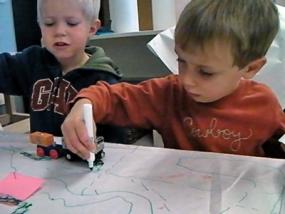Drawing Tracks for Toy Trains

Matthew and Angus work together for 45 minutes, drawing railroad tracks on a papered tabletop, connecting sites (and states) so their train can deliver candy cargo. In offering this setup, the teacher understands that drawing tracks eliminates the limits of using plastic or wooden track segments. The boys draw well and can easily change the direction and interconnection of an inexhaustible "supply" of tracks. In this video sample of their work we suggest you think about the items below in order to decide if these 45 minutes contain value and learning moments.
* Each boy takes a turn drawing short segments of track toward the next city, instead of drawing a long segment all the way to the next city (00:59). This strategy assures the collaborative nature of their work. The rule emerged naturally from their desire to participate as equals.
* The boys look ahead from where the train is now to where it needs to go and calculate the direction and angle required to draw a curved section of track (01:55). The medium, drawing, makes these calculations necessary since there are no pre-formed sections of wooden tracks. The fact that the boys recognize the need to curve the track, even some distance from the destination, reveals their spatial intelligence.
* The teacher wants to help increase the complexity of the children's thinking. Initially they are working to link one track to the closest dot (city). The teacher senses that the boys might be able to mentally step back and study the track as a system of interconnected routes, as opposed to thinking only about the direction the track should point to reach a dot. At several points she asks them, "It there an easier way to get to that city?" (02:56) "Could you use a track you already have?" (03:09)
* To the degree that the boys are successful in responding to the teacher’s question (03:41), they shift from relating one track to one dot and think about the relation of one track to another track and eventually another dot. This new way of thinking requires stepping back to mentally reframe what they are looking at. They are not looking at a list of separate tracks, each with an exclusive connection to one dot. Some tracks may be connections between tracks to create some economy in the system, and some may be used for traveling to more than one city, such as a main line that has spurs to outlying small towns.
* At one point Matthew works on a section that is separate from Angus' work. Angus is keen to draw Matthew back into taking turns on the same track. Notice how Angus is careful to leave enough of the track unfinished so Matthew will have something to do (03:56). Angus calls out, "Matthew, it's your turn." Angus is also keen to say, "We are almost there," (04:03) perhaps to maintain Matthew's interest in working together on one track.
* Consider the value of having the toy trains as moveable objects that travel over the drawn tracks. Quite possibly the moveable trains add narrative and emotion to the game and help to sustain the boys' interest (04:14). Also, the toys add purpose for the drawing and a way to confirm that the tracks create a useable system.
• Finally, consider the scale of this large drawing and the obvious complexity of what the children have produced during these 45 minutes. Most marks were done with a focus on a local objective, but when the boys sit back they are amazed and proud of creating an entire city. Matthew first calls their work a town, but then expands the category to "the whole country" (02:21). Similarly, note the brief discussion of the difference between a city and a state (04:26). Did the idea of a state, "not just cities," come from the boys’ appreciation of the large scale of their work? Of course the class extension of "state" includes the subclass "city." The fact that Angus points to a dot and calls it a state indicates that the class inclusion relation between state and city does not exist in his thinking. But it is through these games that such understandings are gradually constructed. Matthew knows that his city is called Boulder and learns that his state is called Colorado. But it will take a while longer for him to understand that he lives in both places at the same time.
